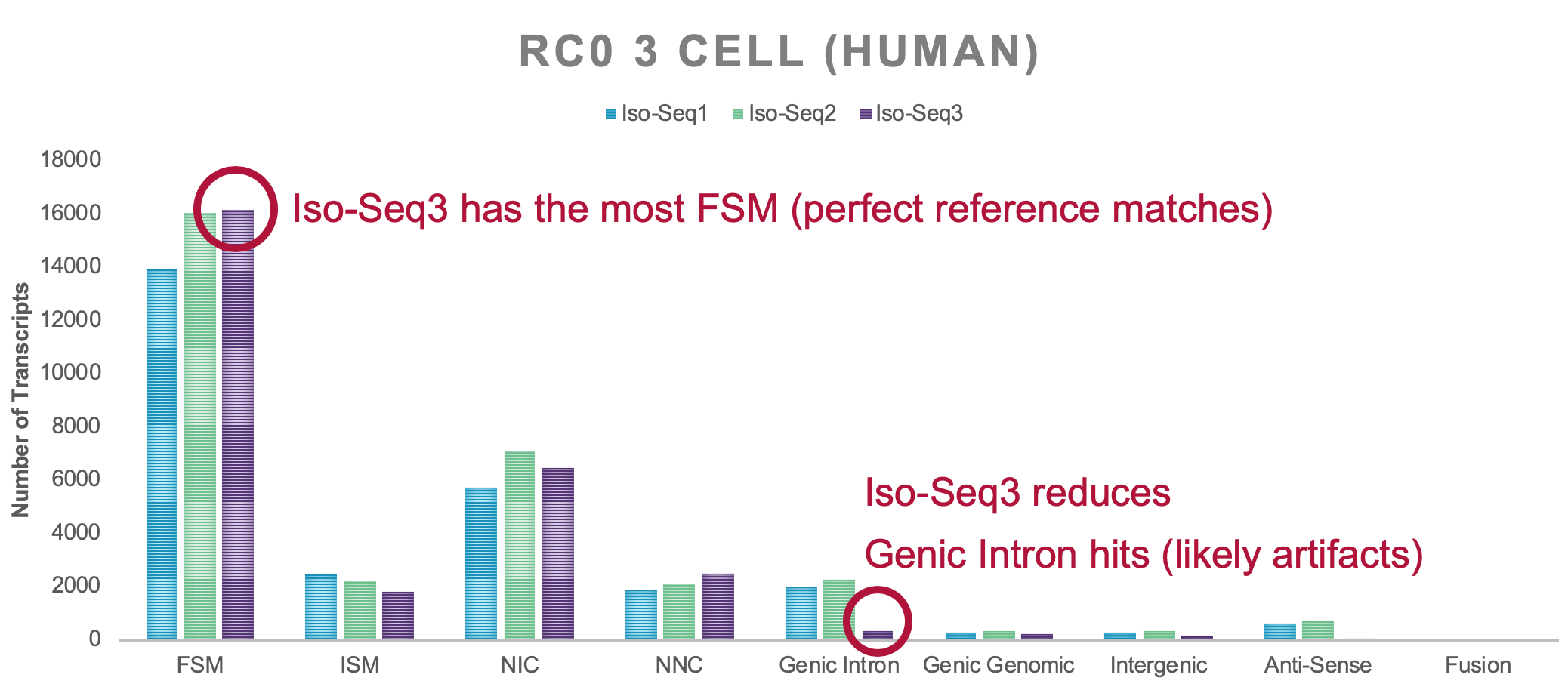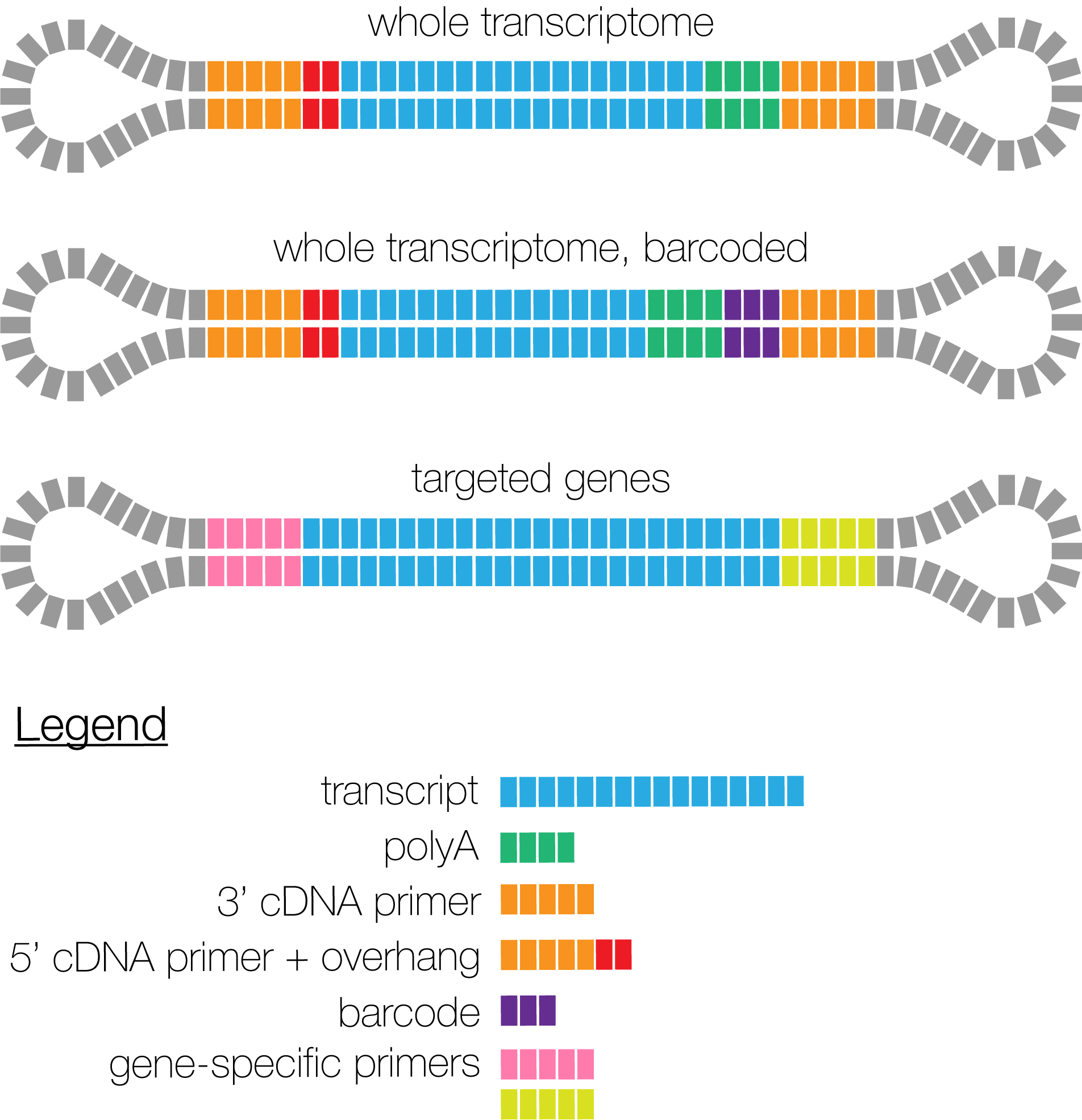Scalable De Novo Isoform Discovery
IsoSeq v3 contains the newest tools to identify transcripts in PacBio single-molecule sequencing data. Starting in SMRT Link v6.0.0, those tools power the IsoSeq GUI-based analysis application. A composable workflow of existing tools and algorithms, combined with a new clustering technique, allows to process the ever-increasing yield of PacBio machines with similar performance to IsoSeq versions 1 and 2.
Latest version can be installed via bioconda package isoseq3.
Please refer to our official pbbioconda page for information on Installation, Support, License, Copyright, and Disclaimer.
- 3.2.2
- Fix
polishnot generating fasta/q output. This bug was introduced in v3.2.0
- Fix
- 3.2.1
- Fix a gff index 1-off bug in
collapse - We have removed implicit dependencies from the bioconda recipe. Please install
pbccs,lima, andpbcoretoolsas needed.
- Fix a gff index 1-off bug in
- 3.2.0
polishdropped support for RS II datasets!- Add
collapsestep for aligned transcript BAM input - Enable CCS-only workflow
cluster --use-qvs - Add
refine --min-polya-length - Add
cluster --singletonsto output unclustered FLNCs; potential sample prep artifacts! - Fix minimap2 bugs. Outputs might change slightly.
- 3.1.2
- Reduce
polishmemory footprint
- Reduce
- 3.1.1
- Edge case fix where
polishwould not finish and stale - Improve
polishrun time for large scale datasets (> 1M CCS) - Improve
polishresult quality
- Edge case fix where
- 3.1.0
- We outsourced the poly(A) tail removal and concatemer detection into a new tool
called
refine. Your customprimers.fastais used in this step to detect concatemers.
- We outsourced the poly(A) tail removal and concatemer detection into a new tool
called
The ever-increasing throughput of the Sequel system gave rise to the need for a scalable software solution that can handle millions of CCS reads, while maintaining sensitivity and accuracy. Internal benchmarks have shown that IsoSeq v3 is orders of magnitude faster than currently employed solutions and SQANTI attributes IsoSeq v3 a higher number of perfectly annotated isoforms:
Additional benefit, single linux binary that requires no dependencies.
Even though we also observe fewer polished transcripts with IsoSeq v3, the overall quality is much higher. Most of the low-quality transcripts are lost in the demultiplexing step. Isoseq v1/2 classify is too relaxed and is not filtering junk molecules to a satisfactory level. In fact, lima calls are spot on and effectively removes most molecules that are wrongly tagged, as in two 5' or two 3' primers. Only a proper 5' and 3' primer pair allows to identify a full-length transcript and its orientation.
Starting with version 3.1, classify functionality has been split into two tools.
Removal of (barcoded) primers is performed with PacBio's standard demultiplexing
tool lima. Lima does not remove poly(A) tails, nor detects concatemers.
For this, isoseq3 refine generates FLNC reads.
For version 3.0, poly(A) tail removal and concatemer detection is performed in
isoseq3 cluster
Use --require-polya for isoseq3 refine.
This filters for FL reads that have a poly(A) tail
with at least 20 base pairs and removes identified tail.
There is no ETA feature. Depending on the sample type, whole transcriptome or targeted amplification, run time varies. The same number of reads from a whole transcriptome sample can finish clustering in minutes, whereas a single gene amplification of 10kb transcripts can take a couple of hours.
In contrast to its predecessors, IsoSeq v3 does not rely on NP-hard clique
finding, but uses a hierarchical alignment strategy with O(N*log(N)).
Recent advances in rapid alignment of long reads make this this approach
feasible.
Cluster uses up to 10 CCS reads to generate the unpolished cluster consensus.
Polish uses up to 60 subreads to polish the cluster consensus.
IsoSeq v3 deems two reads to stem from the same transcript, if they meet following criteria:
There is no upper limit on the number of gaps.
Following BAM tags are being used:
ibBarcode summary: triplets delimited by semicolons, each triplet contains two barcode indices and the ZMW counts, delimited by comma. Example:0,1,20;0,3,5imZMW names associated with this isoformisNumber of ZMWs associated with this isoformizMaximum number of subreads used for polishingrqPredicted accuracy for polished isoform
Quality values are capped at 93.
PacBio supports three different SMRTbell designs for IsoSeq libraries. In all designs, transcripts are labelled with asymmetric primers, whereas a poly(A) tail is optional. Barcodes may be optionally added.
Binaries require SSE4.1 CPU support; CPUs after 2008 (Penryn) include it.
THIS WEBSITE AND CONTENT AND ALL SITE-RELATED SERVICES, INCLUDING ANY DATA, ARE PROVIDED "AS IS," WITH ALL FAULTS, WITH NO REPRESENTATIONS OR WARRANTIES OF ANY KIND, EITHER EXPRESS OR IMPLIED, INCLUDING, BUT NOT LIMITED TO, ANY WARRANTIES OF MERCHANTABILITY, SATISFACTORY QUALITY, NON-INFRINGEMENT OR FITNESS FOR A PARTICULAR PURPOSE. YOU ASSUME TOTAL RESPONSIBILITY AND RISK FOR YOUR USE OF THIS SITE, ALL SITE-RELATED SERVICES, AND ANY THIRD PARTY WEBSITES OR APPLICATIONS. NO ORAL OR WRITTEN INFORMATION OR ADVICE SHALL CREATE A WARRANTY OF ANY KIND. ANY REFERENCES TO SPECIFIC PRODUCTS OR SERVICES ON THE WEBSITES DO NOT CONSTITUTE OR IMPLY A RECOMMENDATION OR ENDORSEMENT BY PACIFIC BIOSCIENCES.



